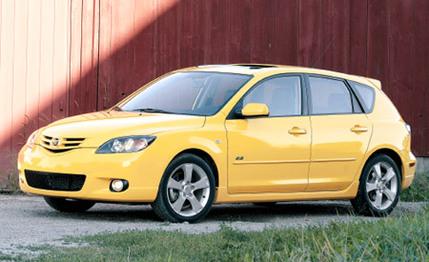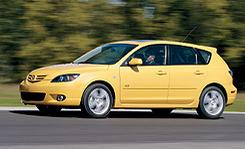
 Road Test
Road Test
Aside from corporate hot rods such as Ford's SVT Focus, compact transportation appliances don't ordinarily generate much of a blip on the collective EKG trace around here. But the new Mazda 3 may be an exception.
That's not a huge surprise, since the 3's predecessor, the Protegé, scored top marks in three successive compact free-for-alls ("Little Cars 6.1," June 2000; "Boxes, Size Small," June 2002; "Double-Dip Dreamboats," November 2002). What is surprising, though, is the character change that marks the transition from Protegé to 3. Light on its feet and eager to please, the Protegé prevailed against cars with more power and, arguably, better value because of its high fun-to-drive index.
The 3 dances to more sophisticated music. Although it responds to driver commands as promptly as its predecessor did—more so, in fact—the puppyesque playfulness of the Protegé has given way to a more serious demeanor that's more purposeful, polished, and substantial. The exuberant teenager is gone, replaced by a hip young adult.
This is an all-new car on a new platform, 40 percent stiffer than the Protegé's body shell, according to Mazda. After living with our test car for a week, we have no reason to doubt this assertion. Like the Protegé, the 3 is supported by struts up front, but there's a new multilink setup at the rear, similar to the system in use on the mid-size Mazda 6. The electrohydraulic power rack-and-pinion steering system is accurate and quick at 2.8 turns lock-to-lock, and the all-disc brake system has bigger rotors, vented up front, and augmented, in our test car, by anti-lock, which is optional.
Like the Protegé, the 3 is offered in two body styles, a formal four-door sedan and a five-door hatch such as our test subject here. Both are bigger than their corresponding numbers from the Protegé lineup. The wheelbase, common to both body styles, has been stretched to 103.9 inches, 1.1 inches longer than the Protegé and among the longest in this class, a plus in the ride department. At 176.6 inches, the new five-door is 6.1 inches longer than the Protegé5. Height remains about the same at 57.7 inches, but width has been expanded two inches, from 67.1 to 69.1, and there's a corresponding gain in front and rear track dimensions: 60.2/59.6 inches for the 3 versus 57.7/57.9 for the Protegé5.

 All the foregoing should add up to a roomier interior, and it does—with one significant proviso. Although rear-seat legroom has improved, a cross-car structural beam encroaches on rear footroom, negating, to some degree, the other volumetric increases. Cargo capacity, on the other hand, has improved, and like the Protegé5, the five-door version of the 3 includes hatchback cargo versatility, thanks to its folding rear seatbacks.
All the foregoing should add up to a roomier interior, and it does—with one significant proviso. Although rear-seat legroom has improved, a cross-car structural beam encroaches on rear footroom, negating, to some degree, the other volumetric increases. Cargo capacity, on the other hand, has improved, and like the Protegé5, the five-door version of the 3 includes hatchback cargo versatility, thanks to its folding rear seatbacks.
Mazda anticipates that two-thirds of the 3's projected 70,000 annual sales in North America will go to the more conservative sedan, essentially a scaled-down version of the Mazda 6 four-door. However, it's the sassy five-door version that's really the showpiece of the new lineup, and design chief Hideki Suzuki cites the Peugeot 307 and Alfa Romeo 147 as inspiration sources for the car's New Age look.
There are several engines available in European and Asian editions of this Mazda world car, including a couple of new diesels, but U.S. models offer two engine options. The base powerplant is an aluminum 2.0-liter DOHC 16-valve four with Mazda's Sequential Valve Timing (S-VT) system, carrying a respectable 49-state rating of 148 horsepower and 135 pound-feet of torque, an 18-hp gain versus the hottest engine offered in the Protegé. Borrowed from the 6's powertrain inventory, the new upgrade engine is a 2.3-liter DOHC 16-valve aluminum four-cylinder with S-VT variable valve timing and variable intake runners, rated for 160 horsepower at 6500 rpm and 150 pound-feet of torque at 4500 rpm.
Transmission offerings include a five-speed manual (standard) and an optional four-speed automatic with a manumatic function. Mazda calls it Activematic and cites an ultra-quick one-two upshift time, contributing to quicker getaways.
Let's talk about those getaways. Equipped with the five-speed manual and the 2.3-liter engine, our tester did the 0-to-60 dash in 7.4 seconds, covered the quarter-mile in 16 seconds flat at 87 mph, and attained 100 mph in 22.8 seconds. Those are remarkable numbers for a car in this class. The only comparable performance in the class was posted by a 180-hp Toyota Matrix in our June 2002 hatchback comparison, and that car scaled in 110 pounds lighter than our hefty 2957-pound five-door Mazda test car.
Other formal test results are equally remarkable. For instance, the car pulled 0.87 g on the skidpad, a distinct improvement on the 0.79 g showing by the Protegé5 back in 2002 and more consistent with sports cars than econoboxes. A 70-to-0-mph braking distance of 169 feet is likewise exceptional.
The 3's interior reinforces the message of those sporty performance numbers: deep-bolstered bucket seats (leather in our test car), with height adjustment for the driver, as well as rake and fore-and-aft; a leather-clad Miata-style three-spoke steering wheel with tilting and telescoping adjustability; high-quality materials and designer textures; classic white-on-black instruments with above-average legibility; a secondary-control center stack that earns high marks for good looks and easy operation; and excellent driver sightlines.